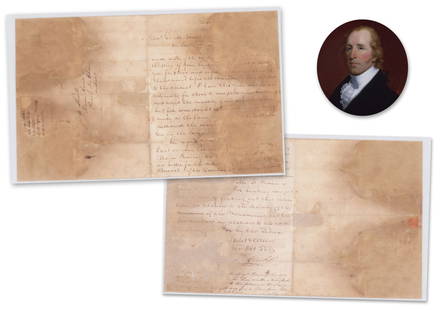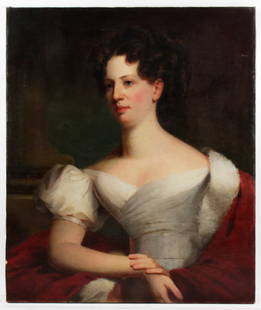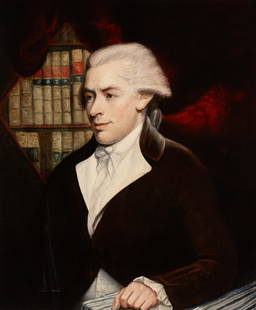
Thomas Wharton LS to William Livingston Re: NJ Prisoners in Philadelphia Prison, Possibly Loyalists
Similar Sale History
View More Items in Militaria & War Memorabilia
Related Militaria & War Memorabilia
More Items in Militaria & War Memorabilia
View MoreRecommended Collectibles
View More









Item Details
Description
Thomas Wharton LS to William Livingston Re: NJ Prisoners in Philadelphia Prison, Possibly Loyalists
A 1p letter signed by Thomas Wharton, Jr. (1735-1778), then in his role as 1st President (Governor) of Pennsylvania, as "Tho Wharton jr Pres." at center right. March 26, 1777. Chamber of the Supreme Executive Council of the Commonwealth of Pennsylvania, in Philadelphia, Pennsylvania. The secretarial handwriting has been attributed to Timothy Matlack (1736-1829), who inscribed a version of the Declaration of Independence in his capacity as clerk to the Second Continental Congress. On cream laid watermarked paper, once bifold, but with the integral address leaf now separated but included. Expected wear including even toning, flattened transmittal folds, and isolated chipped edges. Some minor splits and chips have been repaired. Else very good to near fine. 7.875" x 12.625." The integral address leaf is docketed and bears the remnants of a black wax seal. Minor to moderate soiling, isolated paper loss, and scattered repairs including hinge tabs. Else good to very good.
Supporting documentation
The letter comes with a complete transcript; an RR Auction Certificate of Authenticity from March 2014; and a PSA/DNA Authentication Services Letter of Authenticity, certification number V08665, dated April 4, 2014.
President Wharton wrote Governor Livingston regarding the situation of several prisoners "from the State of New-jersey" who were incarcerated in the "Goal of this city."
In full:
"Sir
Several prisoners from the State of New-jersey, who are confined in the Goal of this city have petitioned for a hearing - But as the Council is wholly unacquainted with their cases, and it being a business not properly belonging to this State, we can do nothing in it, farther than to remind you of their situation by enclosing you a List of them as it is handed to us by the keeper of the prison - [not included in this lot]
The State Prison is much crouded, and many of the prisoners sick, which renders it necessary to take every step which may be proper to lessen their number.
We forbear to press this matter as we are confident your Excellency will pay a proper attention to it -
I am Sr. your Obedient Servant
[signed] Tho Wharton jr Pres.
Council Chamber Philadelphia
March 26, 1777
His Excellency William Livingston Esq. Governor of
the State of New Jersey."
Philadelphia's primary jail since 1776 was the Walnut Street Prison. This U-shaped building designed by architect Robert Smith was located on Walnut Street across from the State House. It replaced the early eighteenth-century stone prison on High Street. Construction of the new prison began in 1773 and was completed by January 1776, when it admitted its first 100+ prisoners. Determining the type of prisoners incarcerated at Walnut Street Prison between 1776 and 1778 is somewhat complicated, because of the changing role the prison played during the Revolutionary War. Over the span of 1776-1778, the prison first sheltered regular prisoners, then Patriot military prisoners, then British military prisoners, and then Patriot military prisoners again. So guessing the identity of President Wharton's New Jersey prisoners in March 1777 is not so simple.
Initially, inmates in the Walnut Street Prison were state prisoners serving time for the usual crimes: armed robbery, counterfeiting, arson, murder, and the like. These regular prisoners were kicked out just a few months later, however, in mid-1776, when Congress requisitioned Walnut Street Prison for a special purpose. As sociologist Thorsten Sellin explains, after mid-1776, the Walnut Street Prison was used exclusively for the "confinement of captured enemies, collaborators, and military personnel." Walnut Street Prison's use as a military prison continued between mid-1776 and 1784,
first housing Patriot military enemies, and then briefly British military enemies during their occupation of Philadelphia for nine months. After the British fled the city, Patriots again used Walnut Street Prison to incarcerate special military prisoners.
If the New Jersey prisoners referred to by President Wharton were indeed inmates of the Walnut Street Prison in March 1777, these men very well could have been Loyalists or British sympathizers. Tories were not viewed as prisoners of war, but as criminals convicted of crimes against the state, i.e., conspiring with the British. [See Thorsten Sellin's excellent article, "Philadelphia Prisons of the Eighteenth Century," "Transactions of the American Philosophical Society," Vol. 43, No. 1 (1953), pp. 326-331.] Non-military prisoners during this time were confined at the old stone prison.
President Wharton's letter hints at deplorable conditions in the city prisons, and urges Governor Livingston to swift action. Prison reforms were necessarily delayed during the American Revolution but came to the forefront after peace. The Philadelphia Society for Alleviating the Miseries of Public Prisons (today the Pennsylvania Prison Society) was established in 1787. Founding members included Benjamin Franklin, Tench Coxe, Benjamin Rush, and a number of prominent Quakers. In 1790, a larger penitentiary was constructed on the site of the Walnut Street Prison that could better accommodate the volume of prisoners. The "Philadelphia System" referred to the progressive concept of providing prisoners with ample food and clothing, sanitary living conditions, and a safe environment free from inhumane treatment or abuse.
Thomas Wharton, Jr.'s tenure as President of Pennsylvania was short-lived. Sending this petition to Governor Livingston was one of his first official acts as president, as he was elected to this role just three weeks earlier, on March 5, 1777. Wharton, Jr. died a year later, in May 1778.
Edward Livingston served as wartime governor of New Jersey between August 1776 and his death in July 1790. Livingston's government was removed to Parsippany, New Jersey for most of the period between 1776 and 1779 because of the threat of British encroachment and encirclement. Livingston was one of the signers of the U.S. Constitution.
This item comes with a Certificate from John Reznikoff, a premier authenticator for both major 3rd party authentication services, PSA and JSA (James Spence Authentications), as well as numerous auction houses.
WE PROVIDE IN-HOUSE SHIPPING WORLDWIDE!
Buyer's Premium
- 28%
Thomas Wharton LS to William Livingston Re: NJ Prisoners in Philadelphia Prison, Possibly Loyalists
Shipping & Pickup Options
Item located in Wilton, CT, usPayment

Auction Curated By




























![[CIVIL WAR - LOUISIANA]. A group of 11 photographs of: [CIVIL WAR - LOUISIANA]. A group of 11 photographs of Union generals, many from the Department of the Gulf, incl. W.T. Sherman, Thomas Williams, KIA Baton Rouge, and Edward Molineux. Philip She](https://p1.liveauctioneers.com/197/224021/115491681_1_x.jpg?height=310&quality=70&version=1635379320)



![[EARLY PHOTOGRAPHY] -- [CIVIL WAR]. Exall - English: [EARLY PHOTOGRAPHY] -- [CIVIL WAR]. Exall - English family archive, featuring correspondence and photographs, incl. pre-war CDV possibly showing William Exall, 21st Virginia Infantry.Approximately 100](https://p1.liveauctioneers.com/197/214395/109691885_1_x.jpg?height=310&quality=70&version=1628790729)




![[CIVIL WAR]. [MEDICINE]. LONGMORE, Thomas (1816-1895). A Tr...: [CIVIL WAR]. [MEDICINE]. LONGMORE, Thomas (1816-1895). A Treatise on Gunshot Wounds. Philadelphia: J. B. Lippincott, 1862. Small 8vo. With printed endleaves, utilized as publisher’s ads. Publish](https://p1.liveauctioneers.com/928/265343/138522426_1_x.jpg?height=310&quality=70&version=1666130009)



![[ROSENTHAL, L. N. (1824-1900), engraver]. Maj. Gen. Wm. T. ...: [ROSENTHAL, L. N. (1824-1900), engraver]. Maj. Gen. Wm. T. Sherman. [Philadelphia: William Smith, Printseller, 1865]. Scarce Imperial folio-sized black and white lithographed portrait of Sherman in un](https://p1.liveauctioneers.com/928/328184/176813693_1_x.jpg?height=310&quality=70&version=1714496988)


![[CIVIL WAR]. Small archive associated with Lt. Col. William M. Vogelson (1831-1892), 27th Ohio: [CIVIL WAR]. Small archive associated with Lt. Col. William M. Vogelson (1831-1892), 27th Ohio Infantry and U.S. Commissary Dept., including a hand-drawn map of frontier stations and a report on "Insp](https://p1.liveauctioneers.com/197/329785/177758363_1_x.jpg?height=310&quality=70&version=1715625218)


![[CIVIL WAR - ANTIETAM - GETTYSBURG]. A group of 12 CDVs of Union generals and officers who saw: [CIVIL WAR - ANTIETAM - GETTYSBURG]. A group of 12 CDVs of Union generals and officers who saw action at Antietam or Gettysburg, incl. Meade, Cuyler, Williams, Franklin, & Burnside. John Meck Cuyler,](https://p1.liveauctioneers.com/197/329785/177758290_1_x.jpg?height=310&quality=70&version=1715625218)












![[CIVIL WAR]. [BELL, William H., photographer]. CDV of a wounded soldier identified as Private George: [CIVIL WAR]. [BELL, William H., photographer]. CDV of a wounded soldier identified as Private George Ruoss, 7th New York Veteran Infantry, featured naked below the waist. CDV on cardstock mount (light](https://p1.liveauctioneers.com/197/329785/177758300_1_x.jpg?height=310&quality=70&version=1715625218)

![[FURNITURE]. Revolutionary War Period British Officer's Por...: [FURNITURE]. Revolutionary War Period British Officer's Portable Campaign Chest. [England, ca. 1770s]. Although not dated, this piece was acquired in upstate New York in the late 1960s and attributed](https://p1.liveauctioneers.com/928/328184/176813337_1_x.jpg?height=310&quality=70&version=1714673807)





![[CIVIL WAR]. Confederate First National flag. Ca 1880s-early 1900s.: [CIVIL WAR]. Confederate First National flag. Ca 1880s-early 1900s. 5 1/4 x 10 in. printed silk flag. Blue canton includes circle comprised of 7 stars (toning, areas of staining, occasional spotting,](https://p1.liveauctioneers.com/197/329785/177758378_1_x.jpg?height=310&quality=70&version=1715625218)

















